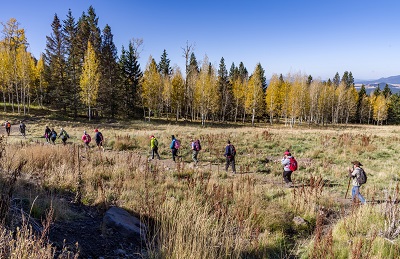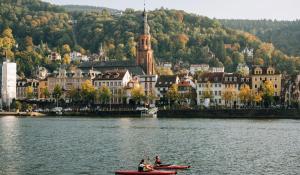
Climate change has wide implications for both coastal and landlocked cities across the globe. But building resiliency and adapting to climate change can have disastrous effects for low-income and minority communities in the form of climate gentrification.
What Is Climate Gentrification?
In a classic example of gentrification, developers see an untapped commercial value in a district and build what they think will attract well-paying consumers. This drives up property values and pushes out residents and businesses that cannot afford the higher cost of living—generally, these displaced peoples are communities of color.
Conversely, climate gentrification is caused by displacement or a fear of displacement—whether that be from devastating natural disasters or extreme changes in weather patterns—that result in people moving to different locations.
“It’s about a shift in consumer preferences,” says Jesse Keenan, an Associate Professor at the Tulane University School of Architecture. “In a classic model of gentrification, you’re talking about a very specific neighborhood or district parts of the city, but with climate gentrification, displacement in Louisiana or Florida could lead to climate gentrification in Atlanta.”
Escaping Rising Seas
A low-lying city with considerable beachfront property, Miami’s coastal areas are already threatened by sea-level rise. As wealthy residents begin to flee their expensive homes by the beach, lower-income neighborhoods are faced with the reality of climate gentrification.
The impacts of climate change are no distant danger—the city saw nearly 20 instances of abnormal floods on otherwise pleasant days in 2018 that made entire stretches of the city unusable until the waters receded. As sea levels continue to rise, these “sunny-day floods” will be increasingly common.
Wealthy Miami residents have long preferred beachfront properties, where housing prices are considerably higher than those in inland neighborhoods. But that’s changing quickly.
Harvard researchers, including Keenan while he was on faculty there, examined changes in housing values. They found that Miami neighborhoods with higher elevation have seen dramatic increases in property values from 1971 to 2017 while low-lying areas have seen a decline in value. This holds true across the city, regardless of proximity to the beach, demonstrating the understanding that any low-elevation area will soon be prone to flooding.
For the residents of high-ground inland areas like the historically Black Little Haiti and Liberty City neighborhoods, these changes represent a sudden and unwanted jump in living expenses, as rents have already begun to increase and some residents have had to leave their homes.

Building Resilient Housing
Fortunately, local governments in those neighborhoods have developed plans to deal with both aspects of the crisis, with the city recently passing a $400 million “Forever Bond” for climate resiliency. Projects funded by the bond will include road reinforcements and the construction of a sea wall, along with $100 million set aside to spend on public and affordable housing.
Meanwhile, Miami-Dade County has launched numerous resiliency projects dedicated to protecting Miami residents, with the recognition that the city has among the starkest income divides in the country. Katherine Hagemann, the Resilience Program Manager for the county, believes that housing needs to be a priority of any climate response plan.
“We know that we have a lot of disparity in terms of wealth and income in our community,” says Hagemann. “So that’s one of our main priorities of autonomy is trying to make sure that we use all of our resources to ensure that new housing units don’t push out residents and to preserve the existing affordable housing.”
The plan and housing grant are useful steps in the fight against climate gentrification, but some residents want to take the preservation of their neighborhood into their own hands. Struggle for Miami’s Affordable and Sustainable Housing (SMASH), an anti-gentrification organization founded to protect the elevated and historically-black Liberty City neighborhood, acts on the belief that a Community Land Trust (CLT) is the most effective way for residents to protect themselves from rising rents.
Trenise Bryant, a long-time resident of Liberty City, has worked with SMASH to create a CLT in her area on which to construct a handful of new, affordable housing units.
“This community land trust is so, so, so important for this community because […] it’s about creating wealth in the community,” said Bryant in an interview with NPR from March 2019. “I wanted to get the voices of the community, making sure their voices are heard ’cause it’s not about me.”
The CLT gives her that ability, as the apartment building constructed on the community land will be run entirely by area residents, giving them leverage over pricing and keeping bigger developers from installing unaffordable units. These projects can be expensive, but in this case, the land was donated.
The people and government of Miami know how little time remains to act on climate, so whether through city-funded or community-led housing, Miami will soon be a model for cities around the country facing similar problems.
Seeking Cooler Climates
On the other side of the country, Flagstaff, Arizona, is dealing with a very different climate problem: heat.
“The 1980s saw a significant shift in our temperatures and so our precipitation is now coming in more rain events than snow events,” says Nicole Antonopoulos, sustainability director for the City of Flagstaff. “A good portion of our economy is made up of tourism, and winter tourism at that.”
Unlike the rest of Arizona, which is known for its desert, Flagstaff sits at 6,909 feet, making it a cool reprieve from the rest of the state. In the past, Flagstaff was most popular during winter for ski season—yet as temperatures reach new records, many of those visitors are returning for summer to escape cities like Phoenix that regularly experience days hotter than 100 degrees Fahrenheit.
“Those are ‘our weekend climate refugees,’ if you will,” says Antonopoulos. “We get, I think, six million tourists a year coming through town and that puts of tremendous impact on our infrastructure. And then when you add in that additional element of climate refugees, even if they’re just escaping the extremes for the weekend, it still has an incredible impact on our natural resources.”
In 2018, the City of Flagstaff published its Climate Action and Adaptation plan to respond to the effects of climate change. It has been well-received by the people of Flagstaff and Antonopoulos attributes this to the thousand-plus community members that were engaged in the drafting process.
“In the last calendar year, we engaged with more than 4,000 members of our community implementing the plan,” says Antonopoulos. “We’ve started our Climate Ambassadors program and our Climate Leaders program, which educate community members about the climate plan and about climate-related issues and to help us communicate our goals, as well as meaningful conversation, and how individuals can take action.”
However, Keenan warns that cities must be wary of deepening inequality when taking climate actions.

Equity as a Foundation
Historically, cities have built energy infrastructure in ways that most benefit wealthier people and neighborhoods, leaving communities of color to deal with issues like lesser access and pollution.
Keenan warns that this pattern could continue in climate plans; what looks like climate resiliency to a wealthy neighborhood may jeopardize a poorer neighborhood, deepening wealth inequality. If cities don’t incorporate equity in their climate plans from the very beginning, vulnerable communities will be left out of important conversations and will be ill-equipped against climate disasters. Therefore, if clean energy infrastructure is to be socially just as well as green, it must be equitably distributed.
Antonopoulos kept this in mind when building the Flagstaff climate action plan. The plan notes that low-income residents, communities of color, and tribal nations disproportionately experience environmental harm and pollution and that these conditions will worsen under climate-related stressors. Like Miami, one such stressor is climate gentrification; however, Flagstaff’s case is unique because much of their population is seasonally transient.
“We have about a 45 percent rental market,” says Antonopoulos, noting that many houses are people’s second or third homes. “So, our demographics are really interesting when we talk about gentrification because houses that are affordable are very hard to come by.”
Flagstaff’s equity strategy includes a checklist that the city government must consider when implementing climate actions, such as sharing benefits, measuring impacts, and building economic opportunity, among others. These considerations were drawn from the City of Portland, Oregon’s climate action plan, which is recognized as a leading document on integrating equity to climate plans.
“[We asked,] how do we incorporate community values and beliefs? And gentrification is a critical part of that conversation as well,” says Antonopoulos.
The city is currently in the process of building a climate and equity working group to build partnerships and engage with its vulnerable communities, as well as identify needs and recommendations for equitable implementation. This includes making sure green infrastructure like renewable energy and resilient housing is available to vulnerable populations.
Resiliency in the Wake of Climate Change
While Miami and Flagstaff are examples of cities taking action, no city is immune to the effects of global climate change and thus, the potential for climate gentrification.
“Climate gentrification has been also caught up with parallel conversations about climate migration and domestic migration, because it becomes a first-order way to think about why people are moving and the implications of where they move to,” says Keenan. “It can operate district-to-district, region-to-region, state-to-state, or even trans-nationally.”
Climate change has the potential to deepen existing inequalities. As cities prepare for climate adaption, engaging vulnerable communities will be the key to enabling social justice and building truly resilient cities.







